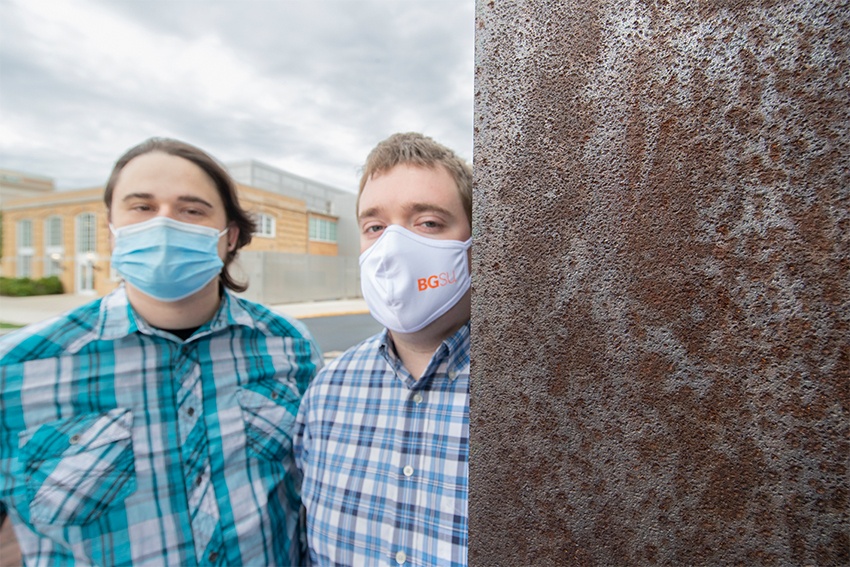
BGSU lab leads 'monumental' research
National Park Service grant funds hybrid coating project to protect monuments
By Julie Carle
A Bowling Green State University researcher has received a National Park Service grant that may eventually result in a process to protect stone monuments from the ravages of acid rain, weather and defacement.
Dr. Joseph Furgal’s research group in chemistry and photochemical sciences received a grant to improve coatings for monument preservation. The grant, which recognizes the impact of the project as a federal priority, is the first competitive, national and externally funded grant for Furgal, who joined the faculty in 2017 following a post-doctoral position at University of Michigan.
In the field of cultural heritage conservation and preservation, protecting stone materials is an ongoing challenge. The grant-funded project, Tri-Cure Hybrid Organo-Silicon Coating, “will address the insufficiencies of current coatings by making a longer-lasting and more easily applicable coating that can be removed on demand,” Furgal said.
Weather and acid rain, a result of air pollution that mixes with water droplets, are among the main villains of monuments, pitting and damaging the surfaces and making them look bad and decreasing their lifespan. The current coatings are not effective when it comes to the high acidity of acid rain. They also are slow to dry and difficult to remove, he said.
Furgal’s coating system addresses those shortcoming of current preservation methods. “We developed a mechanism that can make a material that is more stable to acid rain,” he said. “It also allows the coating to be applied in a way that it becomes harder over time.”
The first of the cure steps is a coating that dries quickly so dust and other debris don’t stick to it during the drying process.
“We can use photochemistry to cause the coating to form a complex shell that becomes harder over time,” he said. Moisture in the air helps to bind the other components in the coating system.
This grant is only one part of a much larger effort in Furgal's lab. In addition to the coating process, his lab team of six Ph.D. students and four undergraduates is working on a method of depolymerization. “That means we can take that coating, apply a certain mix of chemicals to it, and the coating dissolves back to a derivative of the original coating that can be reapplied.”
The science behind the coating involves taking a sulfur component and a vinyl component (typical, everyday plastics like polypropylene and polyethylene), and using a photocatalyst to couple them together, Furgal explained.
“That’s the initial first step cure. Then in the background we have another fast-cure system that’s happening, called epoxy resin chemistry. Those are attached to silicones, which are very water resistant and will keep any acid at bay,” he said.
One of the most exciting parts of the project involves a method to reverse the process. Through depolymerization, the coating can be taken off without harm to the monument. A special solvent mix, discovered by his lab team, deconstructs the silicones and returns them to their original components.
The idea for this project was actually born out of a project he worked on for a friend who was looking for a coating for boats in Florida. His friend was impressed with the coating solution until he learned that the cost was probably restrictive for his business, Furgal said.
Size of the monument or structure most likely will be the determining factor if the Tri-Cure process is a viable option, with the goal of keeping the components as cheap as possible to enable expansive use, he said.
“We’ve designed two different ways that you can apply it – as a spray coating or with a paint roller/brush, making it more versatile.”
One component of the grant allows Furgal to demonstrate how the process works at a couple of National Park Service conferences. He will work with members of preservations teams within the park service to show them how to apply and use the coating. “I think you always learn things better if you do it in person,” he said.
The NPS grant is the introduction of the lab’s research work, but it likely is not the only direction for the process. “Where I envision this going is actually going back to marine or even aircraft coatings,” he said. There may be opportunities in the industry or with the Navy. Instead of paying millions of dollars each year to paint boats, Furgal’s coating might become a cost-efficient way to protect boats from rust, algae and barnacles.
Media Contact | Michael Bratton | mbratto@bgsu.edu | 419-372-6349
Updated: 10/27/2020 09:18AM
